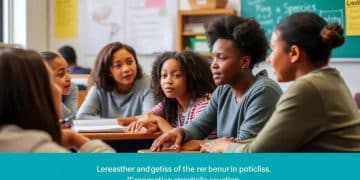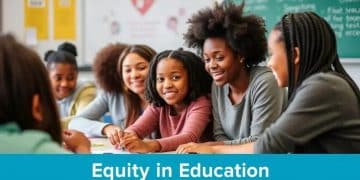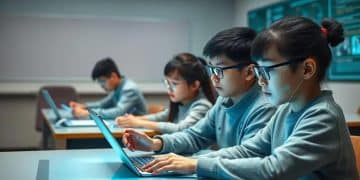Education policy 2025 updates: What you need to know
Anúncios
Community involvement in education systems enhances student success by fostering partnerships between schools, parents, and local organizations, providing valuable resources and support for a more impactful learning experience.
Education policy 2025 updates are set to redefine the landscape of learning. Have you ever wondered how these changes could affect students and teachers? Let’s dive into the latest developments that might shape the future of education.
Key changes in education policy 2025
The key changes in education policy 2025 are pivotal in shaping how students learn and teachers instruct. These updates are designed to address current educational challenges and foster a healthier learning environment.
Increased Funding and Resources
One significant change involves an increase in funding for schools. This boost is aimed at ensuring that all students have access to quality education, regardless of their location or background.
-
💰 More resources for underfunded schools
-
💻 Expanded access to technology
-
🧠 Investment in mental health programs
Another aspect is the emphasis on teacher training programs. The government is now focusing on providing educators with the skills they need to adapt to new teaching methods and technologies.
Curriculum Revisions
The curriculum is also undergoing major changes to better align with the needs of today’s students. Schools will introduce practical subjects that prepare students for real-world challenges.
- Integration of coding and technology in early education
- Focus on critical thinking and problem-solving skills
- Emphasis on environmental education
Furthermore, the push for community involvement in schools is gaining traction. Schools are encouraged to collaborate with local organizations to enhance educational offerings and create more impactful learning experiences.
The landscape of education is evolving rapidly. These changes will not only affect how classes are conducted, but also engage parents and community members more deeply in their children’s learning journey.
Impact of new funding strategies
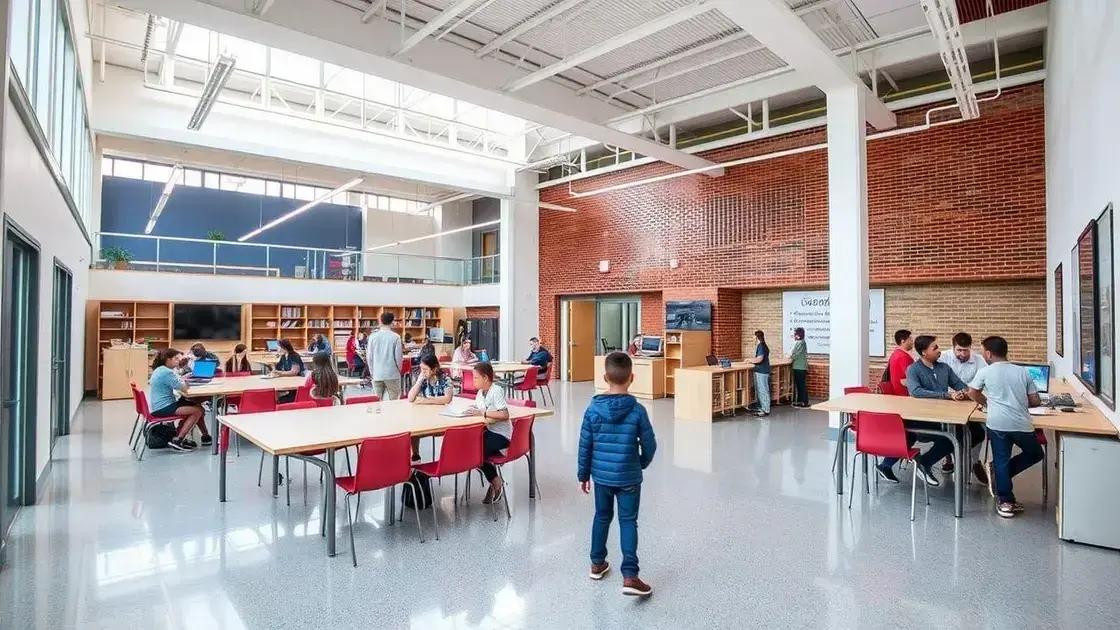
The impact of new funding strategies on education is profound and far-reaching. With increased financial support, schools can now enhance their resources and abilities to provide a better learning environment for students.
Improved Facilities
One of the most noticeable improvements is seen in school facilities. With additional funds, schools can refurbish old classrooms, libraries, and labs, creating spaces that are more conducive to learning.
- Upgraded science laboratories
- Modernized libraries with digital resources
- Renovated common areas for student collaboration
Moreover, these funding strategies also enable schools to incorporate advanced technology into the classroom. This not only makes lessons more engaging but also prepares students for a tech-savvy world.
Enhanced Support Services
Another critical area influenced by new funding is support services for students. Financial resources allow schools to hire more counselors and specialists, addressing the diverse needs within the student population effectively.
Schools can now provide essential services such as tutoring and mental health support. By focusing on holistic development, educators can help students overcome challenges and thrive academically and socially.
As funding increases, the connection between schools and communities also grows stronger. Educators can collaborate with local organizations, which fosters a culture of support and improves educational outcomes for everyone involved. Ultimately, these strategic funding initiatives are paving the way for a brighter future in education.
Shifts in curriculum standards
The shifts in curriculum standards are critical in ensuring that education meets the evolving needs of society. As job markets change and technology advances, schools are adapting their teaching methods and content to prepare students for the future.
Emphasis on STEM Education
One of the key changes includes a greater focus on STEM education—Science, Technology, Engineering, and Mathematics. This focus aims to equip students with the skills they need to excel in high-demand fields.
-
🤖 Increased availability of coding and robotics classes
-
🔬 Hands-on learning experiences in scientific disciplines
-
🤝 Collaboration with local businesses for practical exposure
As schools shift towards a more integrated approach, they are combining subjects like science and mathematics with real-world applications to enhance understanding and engagement.
Incorporation of Soft Skills
Another significant shift is the incorporation of soft skills into the curriculum. Skills such as communication, teamwork, and problem-solving are now seen as essential for student success.
School programs increasingly promote group projects and collaborative learning, which help students develop these skills in a practical setting. These experiences prepare them for their futures, where teamwork and adaptability are crucial.
By focusing on these shifts in curriculum standards, educators are not only teaching knowledge but are also preparing students to think critically and tackle challenges they may face in life. The future of learning is evolving, making education more relevant and impactful for each student.
Enhancements in teacher training programs
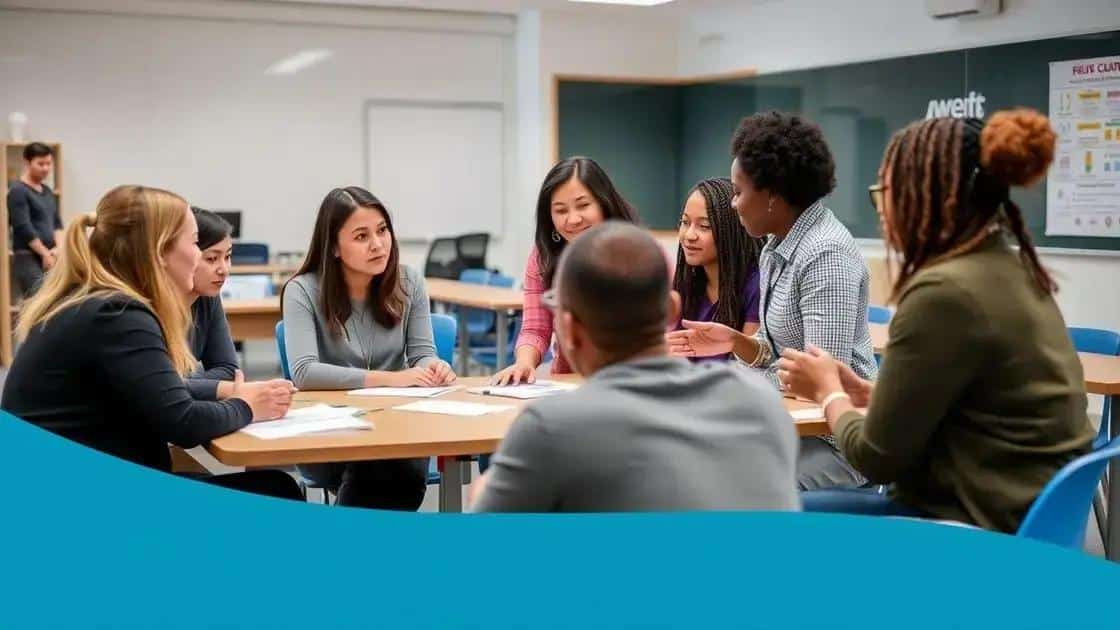
The enhancements in teacher training programs are crucial for improving education standards. With these updates, educators are better equipped to meet the diverse needs of their students.
Focus on Professional Development
One major enhancement is the increased focus on professional development. Workshops and training sessions allow teachers to learn new techniques and approaches to teaching.
- Training on the latest educational technologies
- Workshops on effective classroom management
- Programs that emphasize inclusive teaching strategies
These opportunities for growth help teachers stay current with educational trends and improve their skills continuously. Schools are now more committed to investing time and resources in their staff’s professional journeys.
Collaboration with Experienced Educators
Another significant improvement includes pairing less experienced teachers with mentors. This collaboration helps new educators learn from seasoned professionals while fostering a supportive community.
Mentorship programs encourage sharing best practices, enhancing the overall teaching quality across the school. Throughout the academic year, these partnerships contribute to educators’ confidence and effectiveness.
As teacher training programs evolve, educational institutions recognize that nurturing teachers is essential for cultivating a better learning environment. By investing in teachers, schools ultimately invest in their students’ success, creating a direct link between qualified educators and engaged learners.
Technology integration in classrooms
Technology integration in classrooms is transforming the way students learn and teachers instruct. With the rise of digital tools, classrooms are becoming more interactive and engaging.
Enhanced Learning Experiences
By incorporating technology, educators can create immersive learning experiences. Interactive whiteboards, tablets, and educational software allow students to explore subjects in innovative ways.
-
🌍 Virtual reality field trips for experiential learning
-
💻 Online platforms for collaborative projects
-
📱 Apps that support personalized learning paths
These tools not only make lessons more engaging but also cater to various learning styles. Visual learners can benefit from videos and graphics, while auditory learners can enjoy podcasts and discussions.
Improved Teacher Resources
Technology also provides teachers with valuable resources to enhance instruction. Professional development platforms offer training on the latest educational technologies, helping educators feel more confident in their teaching methods.
With access to a vast array of online resources, teachers can find innovative lesson plans and strategies to meet their students’ needs. This digital shift fosters a culture of continuous improvement and creativity in teaching.
As technology integration continues to evolve, it has the potential to bridge gaps in education. With equitable access to digital tools, all students can benefit, leading to a more inclusive and dynamic learning environment.
Community involvement in education systems
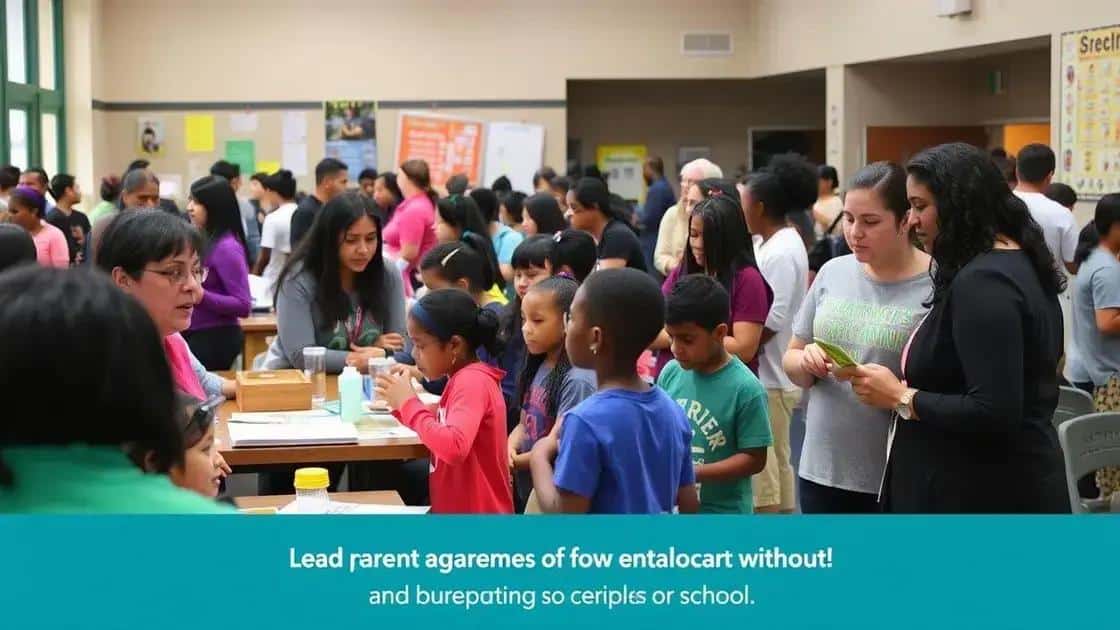
Community involvement in education systems is becoming increasingly essential for fostering a supportive learning environment. When communities engage with local schools, they contribute to the overall success of students.
Benefits of Community Partnerships
Community partnerships bring valuable resources and support to schools. Local businesses and organizations can provide materials, volunteers, and expertise.
- Mentorship programs connecting students with local professionals
- Financial support for school activities and resources
- Workshops that enhance student learning through real-world experiences
These collaborations create a stronger bond between students and their community, showing them the real-world applications of their education. Students feel more connected and motivated when they see active involvement from those around them.
Parental Engagement
Another crucial aspect is parental engagement. Parents play a vital role in supporting their children’s education by participating in school events and staying informed about their progress.
Schools are developing programs to encourage parents to get involved, such as workshops on assisting with homework or discussions on educational topics. By fostering a cooperative environment, schools enable parents to contribute positively to their child’s learning journey.
Ultimately, when communities and schools work together, they create a dynamic support network that enhances educational experiences and outcomes for all students.
FAQ – Community Involvement in Education
How can community partnerships benefit local schools?
Community partnerships provide resources, mentorship, and real-world connections that enhance student learning and engagement.
What role do parents play in school activities?
Parents can support their children’s education by participating in school events, communicating with teachers, and volunteering.
Why are mentorship programs important?
Mentorship programs connect students with experienced professionals, offering guidance, support, and inspiration in their academic and career paths.
How does community involvement improve student outcomes?
When communities work together with schools, students receive better support and resources, leading to increased motivation and improved academic performance.



